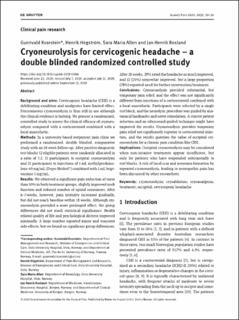| dc.description.abstract | Background and aims: Cervicogenic headache (CEH) is a debilitating condition and analgesics have limited effect. Percutaneous cryoneurolysis is thus still in use although the clinical evidence is lacking. We present a randomized, controlled study to assess the clinical efficacy of cryoneurolysis compared with a corticosteroid combined with a local anaesthetic.
Methods: In a university-based outpatient pain clinic we performed a randomized, double blinded, comparative study with an 18-week follow-up. After positive diagnostic test blocks 52 eligible patients were randomly allocated in a ratio of 3:2, 31 participants to occipital cryoneurolysis and 21 participants to injections of 1 mL methylprednisolone 40 mg/mL (Depo-Medrol®) combined with 1 mL bupivacaine 5 mg/mL.
Results: We observed a significant pain reduction of more than 50% in both treatment groups, slightly improved neck function and reduced number of opioid consumers. After 6–7-weeks, however, pain intensity increased gradually, but did not reach baseline within 18 weeks. Although cryoneurolysis provided a more prolonged effect, the group differences did not reach statistical significance. Health related quality of life and psychological distress improved minimally. A large number reported minor and transient side effects, but we found no significant group differences. After 18 weeks, 29% rated the headache as much improved, and 12 (24%) somewhat improved, but a large proportion (78%) reported need for further intervention/treatment.
Conclusions: Cryoneurolysis provided substantial, but temporary pain relief, and the effect was not significantly different from injections of a corticosteroid combined with a local anaesthetic. Participants were selected by a single test block, and the neurolytic procedure was guided by anatomical landmarks and nerve stimulation. A stricter patient selection and an ultrasound-guided technique might have improved the results. Cryoneurolysis provides temporary pain relief not significantly superior to corticosteroid injection, and the results question the value of occipital cryoneurolysis for a chronic pain condition like CEH.
Implications: Occipital cryoneurolysis may be considered when non-invasive treatments appear insufficient, but only for patients who have responded substantially to test blocks. A risk of local scar and neuroma formation by repeated cryoneurolysis, leading to neuropathic pain has been discussed by other researchers. | en_US |
